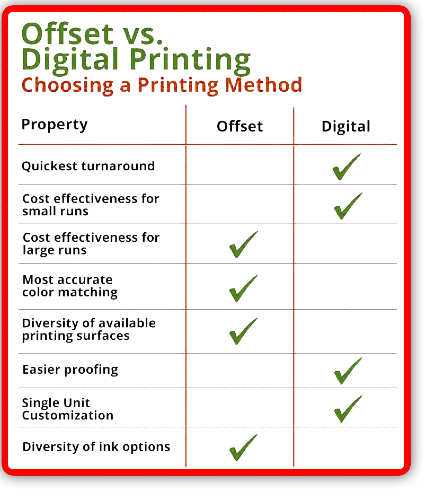The 10-Minute Rule for Digital Printing
Table of ContentsTop Guidelines Of Digital Printing10 Easy Facts About Digital Printing ExplainedA Biased View of Digital PrintingThe Best Guide To Digital PrintingThings about Digital PrintingDigital Printing for Dummies
Variable information printing, such as straight mail with individualized codes and addresses, is preferably suited for electronic printing. Digital fast printing just requires 4 actions of design, review, printing and binding to get every little thing done. Digital quick printing has an unmatched advantage: print on demand.According to PMMI, electronic printing permits brand names and manufacturers to react rapidly to customer needs while enhancing the supply chain, reducing warehousing cost and waste, and enjoying faster time to market. That all noises excellent, yet how does this innovation do all that? The major differentiator of these technologies is that there are no set-up charges and no plates with electronic printing.
Examine This Report about Digital Printing
According to Wikipedia, the best distinction between electronic printing and typical approaches such as lithography, flexography, gravure, or letterpress - Digital Printing is that there is no requirement to change printing plates in electronic printing, whereas in these analog printing approaches the plates are continuously replaced. This results in quicker turn-around time and decreases expense when making use of electronic printing.
Speedy production suggests getting your product to market faster. It also suggests it's simpler and faster to make modifications in the future, when you change a dish, add a SKU, or develop seasonal product packaging. Digital printing is very adaptable, so it's very easy to make changes to the bundle layout promptly. All of it returns to the plates.
With standard printing approaches, short-run printing is simply not possible. Because a great design can make or break your item, electronic printing continually produces top notch, clear and vibrant graphics each time.
Digital printing is the procedure of printing digital-based photos straight onto a variety of media substratums. There is no requirement for a printing plate, unlike with offset printing. Digital documents such as PDFs or desktop publishing data can be sent out straight to the electronic printing machine to publish on paper, picture paper, canvas, fabric, synthetics, cardstock and various other substratums.
See This Report on Digital Printing
According to PMMI, electronic printing enables brand names and makers to respond swiftly to consumer demands while boosting the supply chain, minimizing warehousing expense and waste, and delighting in faster time to market. That all noises wonderful, however how does this technology do all that? The significant differentiator of these technologies is that there are no set-up costs and no plates with digital printing.
According to Wikipedia, the best difference between electronic printing and conventional methods such as lithography, flexography, gravure, or letterpress is that there is no demand to replace printing plates in electronic printing, whereas in these wikipedia reference analog printing techniques the plates are consistently replaced. This causes quicker turnaround time and reduces price when making use of electronic printing.

Not known Facts About Digital Printing
With standard printing approaches, short-run printing is simply not possible. Due to the fact that a terrific layout can make or break your item, digital printing constantly produces top notch, clear and colorful graphics each time.

According to PMMI, electronic printing permits brand names and producers to respond promptly to customer demands while boosting the supply chain, decreasing warehousing cost and waste, and enjoying faster time to market. That all sounds great, but how does this innovation do all that? The significant differentiator of these innovations is that there are no set up charges and no plates with electronic printing.
Our Digital Printing Diaries
This results in quicker turn-around time and reduces cost when utilizing electronic printing.
Speedy production means getting your product to market quicker. It likewise means it's much easier and faster to make adjustments later, when you alter a recipe, include a browse around these guys SKU, or produce seasonal product packaging. Digital printing is very adaptable, so it's very easy to make adjustments to the package style rapidly. Everything goes back to home plates.

How Digital Printing can Save You Time, Stress, and Money.
Digital printing is the process of printing digital-based images straight onto a variety of media substrates. There is no need for a printing plate, unlike with offset printing. Digital files such as PDFs or desktop computer posting files can be sent directly to the electronic printing press to print on paper, picture paper, canvas, fabric, synthetics, cardstock and various other substrates.